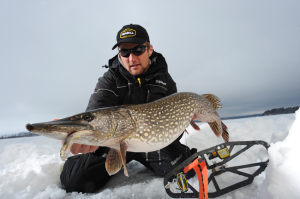Post
Michigan Offers Northern Pike Tips
Michigan Fishing Articles, Regional Fishing, United States Fishing Articles | Michigan theangler PM

Pike spawn in early spring and are usually found in shallow water when the season opens — the last Saturday of April in the Lower Peninsula, May 15 in the Upper Peninsula, though the Great Lakes and connecting waters of the Lower Peninsula are open year-round. As summer progresses, they are found in deeper water, often on the outside edges of deep weed beds. Pike can be taken on live bait (primarily large minnows) and all manner of artificial lures, either by trolling or casting. Large diving or topwater plugs, spoons — the red and white Dardevle is a classic — and spinners all produce. Because of the pike’s sharp teeth, many anglers recommend the use of wire leaders.
Pike are popular quarry of ice fishermen. Though they are primarily pursued with tip ups, baited with live minnows or suckers, they can be taken with rod and reel, either jigging or fishing with bait. Pike are a prime target of spear fishermen as well, who often use decoys or suspend suckers below their shanties to lure pike within range in relatively shallow water.
Inland, the drowned river mouths along the Lake Michigan shoreline – such as Muskegon Lake, Portage Lake and Manistee Lake – are all noted pike waters. Some of the larger inland lakes and reservoirs, such as Michigamme and Houghton, have significant pike populations, though they can be found in many lakes and virtually all the larger rivers in the state.
Unfortunately, pike are susceptible to stunting and many lakes and streams have large populations of slow-growing individuals. In a number of these bodies of water, there is no size limit. Otherwise, pike must be 24 inches to keep and there are a handful of lakes in the Upper Peninsula, and Fish Lake in Barry County, with a 30-inch size limit.
